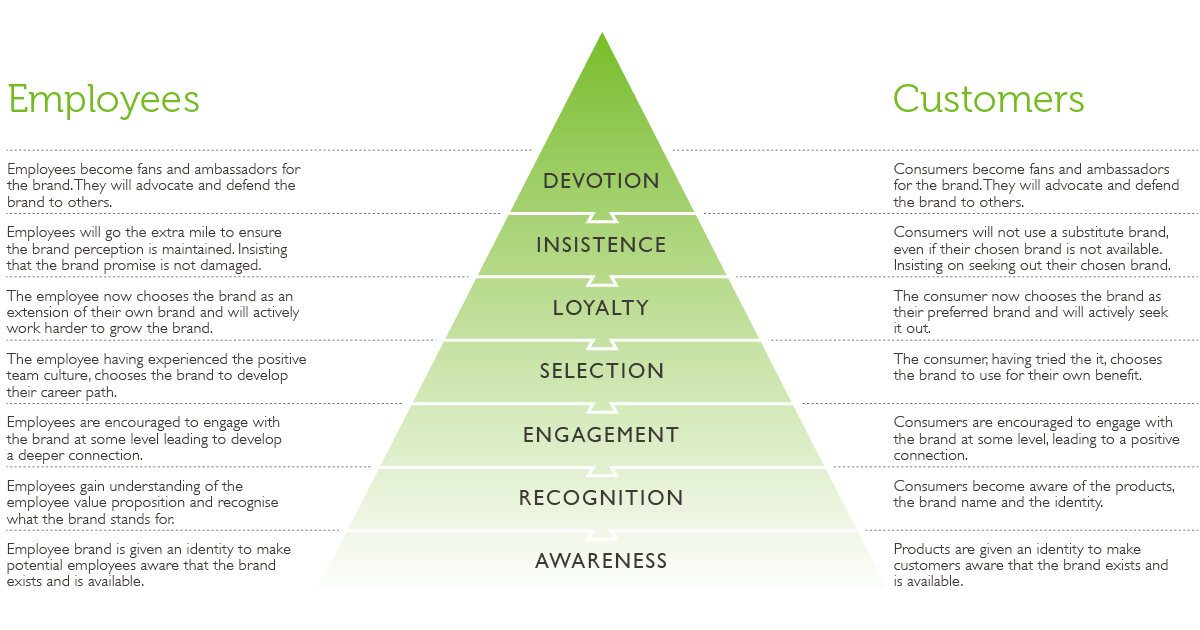Are your Employee and Consumer brands in different places on the Brand Engagement Pyramid?
Our proprietary Seven Steps to Brand Engagement strategic framework and the brand engagement pyramid were developed to strategically marry the employee brand and experience, with the consumer brand and experience, in order for brands to have both holistic views and holistic strategies for their brands.
Our brand engagement pyramid serves as a roadmap for companies looking to build strong brand engagement with both employees and customers. The goal is to be at the apex of the pyramid, for both.
Determining where a company's consumer and employee brand engagement stands is the first step towards aligning them.
There are several methods that companies can use to measure brand engagement:
Surveys and focus groups that gather feedback from customers. These can be conducted online or in-person and should ask questions that assess how customers feel about the brand, including their level of satisfaction, loyalty, and likelihood to recommend the brand to others. Regular tracking of advocacy scores with ongoing surveys has become the norm for many companies looking to stay on top of their engagement.
Similarly, employee engagement surveys can help companies determine how engaged their employees are with the brand. These surveys should ask questions that assess employee satisfaction, motivation, and alignment with the company's mission and values.
A Brand Audit is a strategic tool which looks at your brand in its entirety - understanding where it sits in the market, how it fares against competitors, and how your branding and imagery is viewed. All of which contribute to brand advocacy and engagement.
Once a company has gathered data on both consumer and employee brand engagement, they can compare the results to determine if they are aligned. A company's brand values and mission should be reflected in both employee and consumer feedback. If there is a mismatch between the two, the company should take steps to address the issue.
We've seen the potential consequences of a mismatch between employee and consumer brand engagement in real-world examples.
CASE STUDY: 7-Eleven
In 2016 it was revealed that the company's Australian franchisees were underpaying their employees, often by significant amounts, leading to a widespread exploitation of workers.
This issue revealed a mismatch in the brand engagement of both employees and consumers. 7-Eleven had built its brand reputation on convenience, affordability, and accessibility, which resonated with its customers. However, the exploitation of workers created a negative perception of the company's brand identity, leading to protests, calls for boycotts, and negative press coverage.
On the other hand, the employees who were being underpaid felt a lack of connection to the company's brand values and mission. The exploitation of workers contradicted the values of fairness, respect, and integrity that were supposedly a part of 7-Eleven's brand identity.
7-Eleven took steps to address the issue, including implementing a wage repayment program and establishing a new franchising model to improve employee rights and working conditions.
CASE STUDY: Grill’d
In 2015 and again in 2019, the Australian restaurant chain, Grill'd, faced criticism from employees regarding their pay and working conditions. The company had previously positioned itself as an ethical and sustainable burger chain, which resonated with its customers.
However, employees raised concerns about low pay, poor working conditions, and a lack of job security, leading to a disconnect between employee and consumer brand engagement.
The issue was highlighted when a group of Grill'd employees created a public Facebook group called "Grill'd Gourmet Burgers Employees," (Now Grill’d Workers United) where they shared stories of exploitation and unfair treatment. The group gained national media attention, leading to protests and calls for a boycott from customers. The company rallied to protect their brand.
The discord between employee and consumer brand engagement had a significant impact on Grill'd's reputation and business success. That employee dissatisfaction remains, with Grill’d Workers United, a website and Facebook Community for workers aiming to educate and improve working conditions continuing to operate.
CONCLUSION
In our experience, most companies do not look at their brand engagement holistically. The marketing department takes responsibility for the consumer brand, and the HR or People and Culture leads take responsibility for the employee brand.
“Evaluating these together, and understanding the interplay between them, creates game changing strategies.”
Companies that will succeed and prosper will be those moving their employee brand and consumer brands in unison up the pyramid towards Step 7 - achieving Devotion.
Dovetail Brand Engagement uniquely brings Human Resources, Marketing services and Events management together in order to drive full brand engagement across consumers and employees. More >



